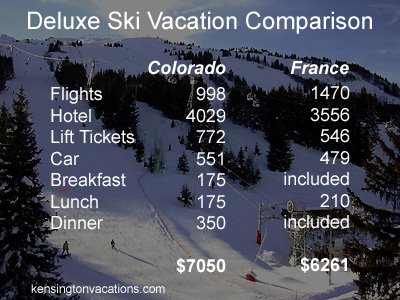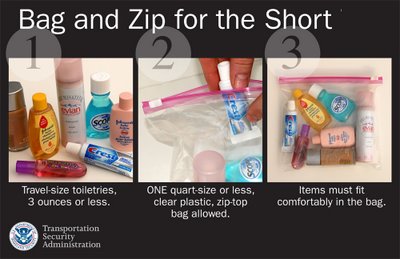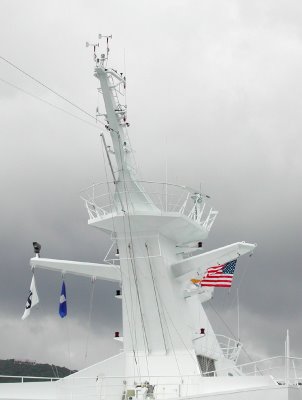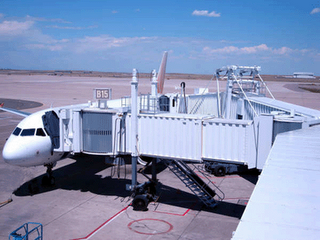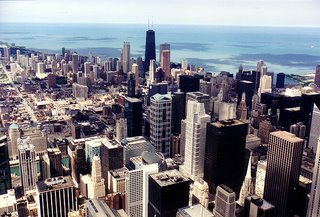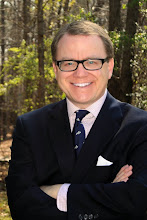The lead photo on the New York Times website was of a Swiss glacier. John Tagliabue's article Frozen In Memories, but Melting Before Their Eyes reminded me of my October 3 post, Glaciers: See Them Before They're Gone. It's an interesting story about how the melting Gletsch glacier is affecting its namesake town.
Tuesday, October 24, 2006
Sunday, October 22, 2006
Art Happened Here: Pissarro & the Hôtel du Louvre, Paris
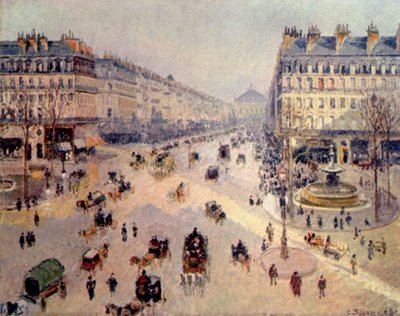 One of Pissarro's paintings of the Avenue de l'Opera completed in 1898.
One of Pissarro's paintings of the Avenue de l'Opera completed in 1898.Photo Credit: Wikimedia Commons
Camille Pissarro spent the first few months of 1898 at the Hôtel du Louvre in Paris. During that time, he produced a number of canvases sitting at the window of his room. Today, that room is the Pissarro Suite and goes for €1800 a night (a little less than $2300). It has a living area, a bedroom and two bathrooms -- all with large windows that overlook the scene that Pissarro painted. You can even enjoy the view from a deep marble tub.
 The view from the Pissarro Suite at The Hôtel du Louvre.
The view from the Pissarro Suite at The Hôtel du Louvre.Photo Credit: Concorde Hotels
The Hôtel du Louvre has one of the best locations in Paris for seeing all of the big tourist sites as it's sandwiched between the Louvre and the Palais Royale. Views from the upper floors take in virtually every monument in Paris and it is located right next to the Palais Royale - Musée du Louvre Métro Station. It's not the neighborhood for anything quaint or quirky, though. This is Baron Haussmann's Paris of the grands boulevards.
The hotel is a distinguished Second Empire building that's managed by the French Concorde group. The decor is indisputably traditional French, but with a contemporary twist, especially with fabric choices. Check out some of the pictures on their website and see what I mean. I have confidently recommended the Hôtel du Louvre for my clients who want a grand Parisian hotel at a level of luxury (and price) just below the true palace hotels like the Ritz, Meurice and Crillon.
 The facade of The Hôtel du Louvre facing the Place André Malraux.
The facade of The Hôtel du Louvre facing the Place André Malraux.Photo Credit: Concorde Hotels
If you're a art lover, it's hard to put a price on the special experience you can have in a place where an artist found their inspiration -- to see the light change through the day and night -- and have the place all to yourself. It's inspirational to me. I will write more in the coming weeks about more places where art happened.
Tweet
Posted by
Christopher Gould
at
1:47 PM
1 comments
![]()
Labels: destinations, hotels DiggIt! add to Del.icio.us
Friday, October 20, 2006
My Top Ten Free & Cheap Things in London
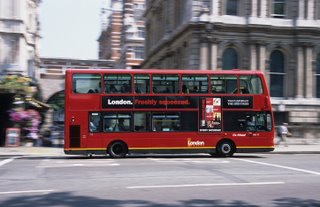 A modern double-decker bus cruises up Whitehall.
A modern double-decker bus cruises up Whitehall.Photo Credit: (c) Transport for London 2005
2. See London from the Thames on a hop-on hop-off cruise. Probably the cheapest way to see the river, this cruise stops at a number of convenient places between Westminster and St. Katharine’s Wharf. With the circular ticket priced at £7, you can get off and rejoin any boat later in the day. Crown River Cruises
3. Changing the Guard may be a tourist cliché, but it's truly is worth seeing, especially for the price (free). Get there early to get a good spot by the fence in front of Buckingham Palace. At 11:30AM Monday - Saturday from April until July and every other day except Sunday the rest of the year. May be cancelled due to rain. Buckingham Palace
4. A Church Service or Concert at Westminster Abbey or St. Paul’s Cathedral. Visiting London’s sacred spaces can be a bit expensive for the tourist. Most of them have daily worship which is, of course, free. See Westminster Abbey and St. Paul’s as they were intended – as places of worship. Most churches also offer concerts and recitals as well, the Church of St. Martin in the Fields in Trafalgar Square is a popular one.
 The Lamb & Flag pub.
The Lamb & Flag pub.Photo Credit: Christopher Gould
5. Have a Pint of ale at a traditional pub. There are literally hundreds to choose from. I like ones in very old buildings with taps that require pumping to draw their precious liquid to your glass. One of my favorites is the Lamb & Flag near Covent Garden at 33 Rose Street. It’s one of the oldest in London, at the head of a crooked street.
6. See debate in Parliament. When Parliament is in session foreign visitors may not take the tour, but they can attend a session of either the House of Commons or House of Lords. Get in line at the St. Stephen’s entrance across from the rear of Westminster Abbey on St. Margaret’s Street. On busy days, the wait can be more than an hour. It is possible to arrange a Card of Introduction through the U.S. Embassy in London that will get you preferred entrance to the session, but they are extremely limited. Admission to the House of Lords is usually easier and their chamber is far more splendid than the Commons. If you appreciate history – remember that the Commons met in the chamber of the House of Lords for most of World War II because of bomb damage to their own chamber. UK Parliament
7. Eat Pie and Mash to experience London's traditional working-class food. There are pie shops all over, with some of the best in the East End. My favorite is Manze’s at 87 Tower Bridge Road. It dates from the reign of Victoria and it's not very different from the day it opened by the looks of it. This is as real as it gets -- traditional meat pie with mashed potatoes and parsley liquor. Expect to pay less than £5 for an entire meal. Truly London in a dish. Manze's
8. Go to the (Puppet) Theatre – An incredible jewel-like theater in tony Islington, The Little Angel Theatre, has presented puppets exclusively since 1961. While their normal ticket prices aren’t bad at all, usually about £9 for an adult, they offer a limited number of PWYC (pay what you can) performances where they request a minimum donation of £1 instead of a ticket. Their elaborate productions dazzle young and old alike.
9. Visit an art museum like The National Gallery in Trafalgar Square which houses treasures like Sunflowers by Van Gogh, Samson and Delilah by Peter Paul Rubens and works by Da Vinci, Vermeer and Michelangelo. The Tate Britain at Millbank on the Thames near Vauxhall Bridge showcases works of British artists, including the world’s largest collection of J.M.W. Turner. If your tastes are more contemporary, check out masterpieces by Picasso, Pollack, Monet, Matisse at The Tate Modern located in the former Bankside Power Station on the Thames opposite St. Paul’s. Admission to all three museums is free.
 The big guns outside the Imperial War Museum.
The big guns outside the Imperial War Museum.Photo Credit: Becky Gould
10. Relive the Blitz and D-Day at the Imperial War Museum. Perhaps the greatest military museum in the world has impressive collections focusing on the First and Second World Wars. The Blitz Experience is unique “a carefully researched reconstruction of an air raid shelter and a blitzed street in 1940. Appropriate sights, sounds and smells evoke for visitors a sensation of being caught in the bombing of London during the Second World War.” The Imperial War Museum is located on Lambeth Road in the landmark buildings that housed the Bethlem Royal (Mental) Hospital, better known as Bedlam in the Nineteenth Century.
Tweet
Posted by
Christopher Gould
at
2:30 PM
3
comments
![]()
Labels: consumer tips, destinations DiggIt! add to Del.icio.us
Tuesday, October 17, 2006
Hassle-Free Car Rental Guide Part 2: Europe

Photo Credit: Christopher Gould
This post will expand upon the advice I gave about car rental in the US last month by examining some important issues to consider when renting a car in Europe. It’s much more important to use a travel professional with lots of European experience (like me) when making a car rental in Europe, this advice is just a starting point:
KNOW WHO YOU’RE DEALING WITH – If you reserve a rental car for use in Europe, in many cases the name of the car rental office may differ from the company you thought you were making the rental with. This is especially true in the case of car rental consolidators like Europcar and Kemwel. You need to know what sign to look for.
Many car rental locations in Europe are independent franchisees that may have a relationship with more than one major car rental brand. I recommend using an experienced travel professional to make your car rental arrangements. They should be able to advise you on the business practices of different companies from country to country. It can be quite complicated – in fact, there’s only one company that I recommend in every European country – other companies I might recommend in France but not in Ireland, for example.
GET THE EXACT LOCATION AND HOURS – Locate the rental office on a map in advance of attempting to drive there – get expert advice because house and building number logic may be different from what you’re used to. Be sure to find out the hours of operation for the car rental office you’ll be using. Many on-line reservation websites will let you make a reservation during hours that a location is not open. Be sure.
KNOW WHAT YOUR INSURANCE COVERAGE IS – See my previous post for an overview and be sure to know how your insurance applies in the countries you’re planning to drive in.
KEEP RENTAL AGREEMENT WITH THE CAR – You will need to show the rental agreement if you’re stopped by police and at some border crossings.
DON’T PUT GAS IN A DIESEL CAR – One of the most common mistakes that Americans make with cars in Europe is putting the wrong kind of fuel in the tank. Diesel cars are much more common in Europe and you may get one when you rent. If you put gasoline in a diesel car (or vice versa), you will break down, and it will cost you hundreds of dollars to correct the mistake. Understand that you cannot request one type or another when you make your reservation – you can make a request when you pick up the car if you have a preference – the important thing is to use the right fuel when you fill up.
KNOW THE LOCAL LAWS – Ask your travel professional to help you understand the local laws regarding cars and driving. The laws are not the same and you are responsible for obeying them. Here are some interesting examples: in Ireland you may not drive if you’re older than 75; you may not honk your horn in town in France; in Italy you must wear a reflective vest if you must get out of your car on a highway; in Austria you must display a sticker to show you’ve paid the toll for some roads; some countries require that you carry an International Driving Permit. The list goes on and on – don’t be surprised – find out before you drive.
TAKE YOUR TIME – Remember that you’re on vacation, there’s no need to rush.
Tweet
Posted by
Christopher Gould
at
11:02 AM
0
comments
![]()
Labels: car rental, destinations DiggIt! add to Del.icio.us
Saturday, October 14, 2006
Alert: French Rail Strike Set For Nov. 8
 The TGV Atlantique train speeds through the French countryside.
The TGV Atlantique train speeds through the French countryside.
Photo Credit: SNCF
The five major railway workers' unions in France yesterday agreed to hold a one-day strike on Wednesday, November 8. The unions are dissatisfied with their negotiations with the French national railroad company.
I expect that there will be an almost complete cessations of all rail operations in France on that day -- as has happened during previous work stoppages. Local trains and TGV service will most likely be halted. International service, including the Eurostar and Thalys trains should be greatly reduced, if not completely stopped as well.
It is not clear if the Paris Métro and Paris regional rail (RATP) will strike as well, but I expect disruptions at a minimum. Other cities that have Métro systems: Lyon, Toulouse, Rennes, Marseilles, and Lille; will most likely suffer significant disruption.
If you're scheduled to travel by rail in France on November 8, my advice is to reschedule now. If you're not -- it's an opportunity to see a great French labor movement in action.
I will continue to monitor the situation and post updates as required.
Posted by
Christopher Gould
at
10:40 AM
0
comments
![]()
Labels: destinations, rail travel DiggIt! add to Del.icio.us
Thursday, October 12, 2006
Lonely Phones: Nassau, Bahamas
Photo Credit: Christopher Gould
Posted by
Christopher Gould
at
9:27 AM
0
comments
![]()
Labels: destinations DiggIt! add to Del.icio.us
Wednesday, October 11, 2006
Top Five TV Travel Shows
 Michael Palin surveys Bombay in Around the World in 80 Days.
Michael Palin surveys Bombay in Around the World in 80 Days.
Photo Credit: Julian Carrington, Prominent Palin Productions, Ltd.
Because I found myself enjoying that show so much, I thought of sharing my selection of the top ten travel shows ever on television. Upon reflection, I couldn't think of that many quality shows. The Travel Channel, ostensibly created to fill this void, is the most disappointing network on TV for me. Its programming is mostly crap, especially their leading program, World Poker Tour. So, instead of ten, I give you my top five:
1. Around The World In 80 Days
The BBC produced this seven episode series in 2001 that followed Monty Python star Michael Palin in an attempt to duplicate the feat of Jules Verne’s literary hero and circle the globe in 80 days or less. Palin sets out to match the route of his fictional predecessor and avoids using modern air transportation. The journey is delightful for the viewer because of Palin himself. He is sensitive, intelligent, guileless and hilarious as he makes his way and having fascinating encounters with the locals on his journey. This show is the gold standard in travel television.
2. Anthony Bourdain: No Reservations
This show has partially redeemed the Travel Channel for years of stupid programming. Bourdain is wickedly funny as he visits disparate destinations like Iceland, Vietnam and New Jersey giving his unfiltered take on local foods and atypical typical tourist activities. This is a personality-driven show filtered through the lens of America’s leading punk chef novelist.
 Rick Steves on location in Salamanca, Spain.
Rick Steves on location in Salamanca, Spain.Photo Credit: Rick Steves' Europe Through the Back Door, Inc.
3. Rick Steves’ Europe
For many Americans, Rick Steves personifies travel in Europe. His little show on PBS has transformed the mild-mannered pot smoking Lutheran into today’s leading travel guru. In the past 10 years he’s produced over 70 quality shows based on his philosophy of packing light and digging deep into the local culture for a rich rewarding experience. If you don’t subscribe to his budget style, his shows and guidebooks are still among the only ones that give honest opinions, and are particularly strong if you share Rick’s passion for art.
4. Full Circle
Michael Palin makes another epic journey, this time around the Pacific Rim from the Arctic, coastal Asia, Australia, Antarctica, South America, North America and back to the Arctic. Again, it is Palin the host and traveler that makes the series so memorable, an everyman exploring for the rest of us.
5. Going Tribal
This incredible show follows adventurer Bruce Parry, a former Royal Marine, as he seeks knowledge from so-called primitive peoples around the world. He sets out to live with a tribe for at least a month, learn their language and live as they do. This is true armchair travel for me, because I can’t imagine doing what he does. Parry has profound respect for the people he lives with, I can imagine that this premise could have easily come off as exploitative or insensitive, but he pulls it off. At the end of each show there’s genuine regret and often tears as he parts with the tribe.
Honorable Mention: The Amazing Race
This is the best network reality show on TV, in my opinion – especially interesting because the contestants have existing relationships they bring into the show. They have covered the globe and race through both famous and offbeat locales. I love to imagine myself on the show, outdistancing the others with my encyclopedic knowledge of the world’s travel infrastructure. I know that will never happen because there’s no way I will ever bungee jump or hang glide.
Posted by
Christopher Gould
at
11:34 AM
4
comments
![]()
Tuesday, October 10, 2006
A Cozy Castle Hotel In Wales: Ruthin Castle
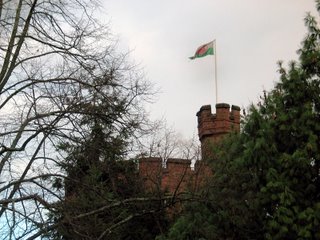 The red dragon flag of Wales flies over Ruthin Castle.
The red dragon flag of Wales flies over Ruthin Castle.
Photo Credit: Stephen Fulljames
Castles have fascinated me since I was a little boy, and castle hotels are something that I’ve devoted considerable time to studying, both for my own travel and that of my clients. If you seek castles, Wales should be at the top of your list with the world’s highest concentration, over 500 castles -- imagine all those castles in an area the size of Vermont.
If you come to Wales in search of castles, you should sleep in one too. In northern Wales, the choice is clear; Ruthin Castle offers a strategic location for controlling the Clwyd Valley (in the past) or for exploring northern Wales as a tourist (present-day). The 62 room hotel is accommodated in an early 19th Century building that sits amid the extensive ruins of a 13th Century Castle.
The grand public rooms are filled with original art and furnishings that transport me back 100 years to the time when Edward VII visited the castle. I found photos of that visit on the main staircase. I also noticed that the group pictured included Lady Randolph Churchill (Sir Winston’s mother). After she was widowed, Lady Randolph married George Cornwallis-West, whose family owned Ruthin Castle. He was over 20 years her junior, and reportedly one of Britain’s most handsome men.
I’m told that Edward VII’s great-great grandson, Prince Charles has visited Ruthin Castle much more recently.
The rooms are each unique with very high ceilings and some with fireplaces. The furnishings are comfortable and old, what you might find in the home of a respectable British granny. That for me was important to the feeling of charm at Ruthin Castle. It felt lived-in, as if the Cornwallis-Wests were awaiting you in the smoking room downstairs while your man unpacked your bags. The modern bathrooms have a cozy feel and feature deep tubs and traditional tilework.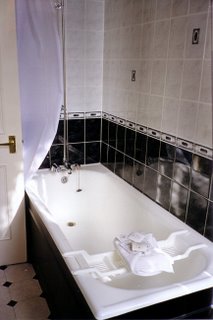 Our bath at Ruthin Castle.
Our bath at Ruthin Castle.
Photo Credit: Christopher Gould
Our room had views over the gardens and ruins with the River Clwyd below and sheep-dotted hills beyond. It was a sunny day in May, but there was a refreshing chill in the stiff breeze that blew in our windows. It was a view that must be nearly unchanged for centuries. Ruthin Castle is for looking out of rather than looking at. I realized this when I discovered that I had no overall view of the castle among my photos. It’s hidden behind trees and a gatehouse as you approach from town – the visual memory I took away from Ruthin Castle was of its commanding views of the Welsh countryside. Some of the ruins of the old castle.
Some of the ruins of the old castle.
Photo Credit: Becky Gould
The castle gardens are beautifully maintained and wind around and through the picturesque ruins. Large pieces of curtain wall, windows, and arches remain in the local red sandstone that give the castle its name, which is derived from the old Welsh words meaning “Red Castle.” A number of peacocks live in the garden and walk the pebble pathways with you.
Ruthin Castle is located in Ruthin, a small, pretty town that offers all of the basic services a traveler could wish for. It’s conveniently located in Denbighshire between Chester, England and Caernafon, Wales. I’ve used it as a base of operations for exploring Snowdonia National Park and towns like Llangollen, Betws-y-coed and Blaenau Ffestiniog.
Posted by
Christopher Gould
at
11:13 AM
0
comments
![]()
Labels: destinations, hotels DiggIt! add to Del.icio.us
Saturday, October 07, 2006
Thailand Coup No Big Deal for Tourists
I always closely watch events around the world for the purpose of predicting traveler safety. The recent coup in Thailand immediately drew my concern due to the large number of tourists who travel there. For my little business it's the second largest destination country in Asia, behind China.
I'm happy to say it has been a non-event for any traveler disruptions. I haven't heard anyone from any media source regret the forced exile of Prime Minister Thaksin Shinawatra -- nobody seems to miss this guy.
I saw an interesting article in today's New York Times that reports how there's been no disruptions at all for tourists. The photo of the woman gleefully posing with assault rifle toting soldiers tells the whole story.
Posted by
Christopher Gould
at
9:08 AM
0
comments
![]()
Labels: destinations DiggIt! add to Del.icio.us
Wednesday, October 04, 2006
Skiing In Europe: It's Cheaper Than You Think
Air travel to Europe in the winter is generally the cheapest all year, European lift tickets are a great buy and European ski hotel packages include valuable extras not usually found in the U.S. To illustrate this, I priced a real-world vacation for two people shown in the graphic above. For this comparison, I chose luxury resort hotels that are acknowledged to be among the best in their areas.
In the Colorado example, I chose the Vail/Beaver Creek Ski Area; the hotel: The Ritz-Carlton Bachelor Gulch. The rate shown is for a standard lodge room and includes all taxes and fees and no meals. This gorgeous resort offers luxury accommodations and a true ski-in / ski-out experience. Six-day lift tickets for two allow unlimited skiing at Beaver Creek and Vail Mountain, the largest ski area in the United States. The car is a standard SUV from Hertz including all taxes and fees, but no additional insurance.
For my French example, I chose Courchevel, one of the villages in the Trois Vallées ski area, the largest in the world. My hotel choice is the Hôtel Byblos des Neiges in a standard room. The Byblos is a small luxury hotel with one of the best restaurants in the area. European ski hotels are usually smaller than their American counterparts and are sold with meal plans. The rate I used includes breakfast and dinner each day – this can be a substantial savings when compared to the U.S. Six day lift tickets offer unlimited skiing throughout the Trois Vallées and there is a less expensive ticket option that includes only the Courchevel Valley. The car I priced is a manual shift midsize car from Hertz. This type of car is in the middle of the price range for rental cars in Europe – an automatic shift will add substantially to the price.
Of course, you have to fly a little farther to get to Europe. I priced tickets on American Airlines from Raleigh-Durham to Vail/Eagle County (for Colorado) and from Raleigh-Durham to Grenoble, France. Grenoble is not the cheapest ski gateway to Europe to use. If price is a big concern flights to Zurich, Geneva and Munich can be substantially less, and they have great ski areas nearby. There are other options for reaching the French Alps too – fly to Paris and take the high speed train (TGV). During ski season there are special ski train express departures.
My example uses top-end hotels. More moderately priced hotels are available in Europe and the U.S. – just make sure you talk with an expert in making your plans. Consider Europe the next time you’re planning a ski vacation, it’s more affordable than you think.
Posted by
Christopher Gould
at
11:58 AM
1 comments
![]()
Labels: destinations DiggIt! add to Del.icio.us
Tuesday, October 03, 2006
Glaciers: See Them Before They're Gone
I’ve always been impressed by the incredible spectacle that glaciers provide. I can’t think of a better way to see the forces of nature in action. Natural climate change accelerated by man-made global warming is causing many of the world’s glaciers to recede at a rate faster than ever recorded. Some of the glaciers most accessible to travelers are in danger of disappearing in our lifetime. So if you want to see them, travel soon and bring your camera.
Here’s where to see some of my favorite glaciers that are accessible without too much effort:
Glacier National Park, Montana: The largest concentration of glaciers in the Continental United States is melting away. According to the park website “The glaciers in Glacier National Park are melting. In 1850, 150 glaciers covered the landscape. Today in 2006, there are only 27 glaciers left inside the park, a 75-80% decrease. If current warming trends continue, it is projected that between 2030 and 2050, there will be no more glaciers in Glacier National Park.”
Glacier National Park offers the chance to see the disappearing glaciers from your car or from a bus tour. Hikers and backpackers can get much closer to the action. Mer de Glace
Mer de Glace
Photo Credit: Christopher Gould
Chamonix, France – This fabled winter resort in the shadow of Mont Blanc is home to Europe’s second largest glacier, the Mer de Glace. A cog-wheel train travels to the glacier from the center of Chamonix in only twenty minutes. There’s a spectacular overlook and little cable cars will take you down to the glacier itself where you can explore a man-made ice cave, the obligatory glacial attraction. I love the unearthly blue glow within the ice with the constant dripping in summer. The industrious French don’t let the drips go to waste; the meltwater of the Mer de Glace generates electricity in a little hydroelectric station.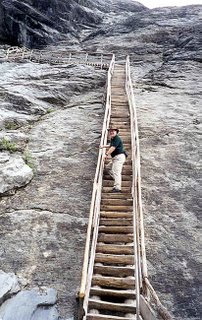 The steps to the Ober Grindelwald Glacier
The steps to the Ober Grindelwald Glacier
Photo Credit: Becky Gould
Grindelwald, Switzerland – The postcard-perfect Grindelwald Valley is home to a walk-up glacier (if you don’t mind a 1500 step wooden staircase). The Ober Grindelwald Glacier is a small glacier that’s receding up its valley. It is a perfect geology lesson as you walk up the small valley with less and less life as you approach the glacier, the bare rock just recently uncovered for the first time in centuries. Inside Ober Grindelwald Glacier
Inside Ober Grindelwald Glacier
Photo Credit: Christopher Gould (timer)
Glacier Bay, Alaska – Glacier Bay National Park offers a large-scale version of the same geology lesson where the enormous Glacier Bay has been uncovered in the last 250 years as glaciers receded. Most visitors visit the park aboard cruise ships – it’s only accessible by water and air. Viewing Hubbard Glacier from Radiance of the Seas.
Viewing Hubbard Glacier from Radiance of the Seas.
Photo Credit: Becky Gould
Disenchantment Bay, Alaska – Located in the Wrangell-St. Elias National Park and Preserve, Disenchantment Bay is home to Hubbard Glacier, the largest tidewater glacier in North America. Tidewater glaciers advance all the way to ocean waters where huge pieces “calve” and break off with a thunderous sound. Hubbard Glacier is advancing and its face measures over six miles wide. Cruise ships have recently begun to visit this incredible glacier.
Bernardo O’Higgins National Park, Chile – Hubbard Glacier’s South American twin is the Pio XI Glacier. South America’s largest tidewater glacier is most easily seen by cruise ship or tour boat.
Posted by
Christopher Gould
at
1:03 PM
0
comments
![]()
Labels: cruises, destinations DiggIt! add to Del.icio.us
Sunday, October 01, 2006
A Vintage View of the Matterhorn
If you're interested in climbing the Matterhorn, I talk about that a little on the Kensington Vacations website -- click the photo of the castle next to "Seeing the Sights."
Photo Credit: Christopher Gould Collection
Posted by
Christopher Gould
at
10:47 AM
0
comments
![]()
Labels: destinations DiggIt! add to Del.icio.us
Wednesday, September 27, 2006
Airport Carry-on Update
This is a follow-up to my post on Monday after one full day of implementation of the new TSA carry-on regulations. It appears that all major U.S. Carriers are adopting the TSA regulations without any internal modifications. This is good news as it will cut down on confusion.
Flights on all carriers to international destinations are subject to different requirements. Some of the most restrictive rules concern itineraries where you make a connection in the United Kingdom. Be sure to check with your airline or travel professional if you’re flying internationally. Many foreign flag carriers have not updated their websites to address the new carry-on rules.
One final observation: media reports suggest that many travelers have overlooked the TSA requirement that the small size liquids be packed in a one quart size clear plastic bag. That bag is only slightly larger than a sandwich bag. Don’t show up with a gallon bag – you won’t be allowed through security with it.
Posted by
Christopher Gould
at
9:54 AM
0
comments
![]()
Labels: air travel, consumer tips DiggIt! add to Del.icio.us
Tuesday, September 26, 2006
The Myth of Getting Bumped
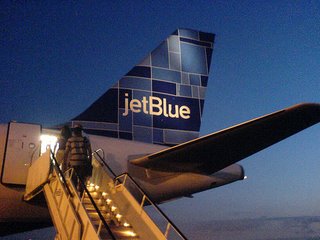 jetBlue is the IDB champ with only one IDB per 140,629 passengers (Jan. - June 2006).
jetBlue is the IDB champ with only one IDB per 140,629 passengers (Jan. - June 2006).
Photo Credit: Joe Popp
Since I started blogging I’ve taken an interest in reading other travel-themed blogs, especially those that dispense advice. I’ve been surprised to see one topic covered exhaustively: the issue of getting bumped from a flight. The precise term of art is Involuntary Denied Boarding (IDB) and it describes the situation where a passenger holding a ticket for a flight is not allowed to fly (against their wishes) because the airline has overbooked.
The experts go on at great length talking about the airlines’ Contract of Carriage, their obligations under Department of Transportation (DOT) regulations etc. Apparently this is a topic that people are very interested in.
It’s an unreasonable fear. Passengers are seldom denied boarding against their will. It’s never happened to me, my family, my friends, or any of my clients. In fact, because airlines are required to report Involuntary Denied Boardings to the DOT the actual statistics are available for review.
During the first six months of 2006, 1.22 passengers were denied boarding involuntarily for every 10,000 passengers. If that statistic held true in the future, you could fly every day for twenty years before it happened to you. In 2005, the same period resulted in 0.97 IDBs per 10,000 passengers.
We all know that airlines routinely overbook flights – if there’s a problem it’s usually handled through voluntary denied boarding. That’s where passengers volunteer to skip the flight for a later one in return for some kind of compensation like a free ticket or cash. I’m one of those people who hope it will happen so I can get the free ticket. How do you think I took my family on vacation this year anyhow?
So don’t worry about getting bumped, it probably won’t ever happen to you. Worry about something realistic – like weather-related flight delays – but that’s another post…
Posted by
Christopher Gould
at
12:33 PM
0
comments
![]()
Labels: air travel, consumer tips DiggIt! add to Del.icio.us
Monday, September 25, 2006
Alert: TSA Refines Liquid Ban for Air Travel
Small size (less than 3 oz.) containers will be allowed if carried in a single, one quart size, clear zip-top bag. Additionally, travelers will be allowed to carry beverages purchased in the secure area of airport terminals onboard.
I think that it's important to point out (and I haven't seen anyone in the media address this) that the ability to board with beverages, indeed with any liquid is at the discretion of each airline. I'll be watching to see what they do. I expect that most will follow the TSA's lead -- but I'm sure that one or two will not.
Posted by
Christopher Gould
at
1:41 PM
1 comments
![]()
Labels: air travel DiggIt! add to Del.icio.us
Top Hotels Make Special Plans For Younger Guests
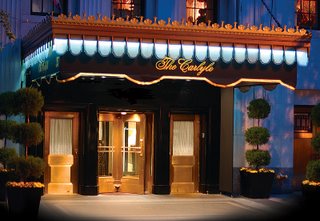 The Carlyle Hotel Entrance
The Carlyle Hotel Entrance
New York
The Carlyle – This legendary hotel is discreet and jewel-like, conveniently located in a tony neighborhood on the Upper East Side. It was the hotel of choice for President John F. Kennedy, Ingrid Bergman and Diana, Princess of Wales. It’s also been a focus of café society since Composer Richard Rodgers moved in when the hotel opened in 1930. The Café Carlyle has attracted music lovers for years with classy performers like Bobby Short, who headlined at the Carlyle for 37 years.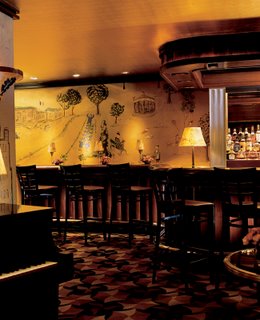 The Carlyle's Bemelmans Bar
The Carlyle's Bemelmans Bar
Another of the Carlyle’s famous spaces is the Bemelmans Bar, named for the author and illustrator of the Madeline books, whose murals cover the walls. Children and their parents are invited to come for a Madeline-themed high tea afternoons from Wednesday through Sunday. Special snacks and desserts like Pepito’s crudités and Eiffel Tower Hot Fudge Sundaes help make the experience memorable. Kids may want to study the murals to find where Bemelmans included Madeline and her classmates. Oh, if your name is Madeline – the whole experience is on the house. The Merrion Hotel's Georgian Door
The Merrion Hotel's Georgian Door
Dublin
The Merrion – Topping every hotel guide for Dublin is this elegant hotel located between Merrion Square and St. Stephan’s Green. The Merrion is located in four elegant Georgian town homes, including Mornington House, birthplace of the Duke of Wellington. Providing more than luxury lodging, today The Merrion boasts Ireland’s most exclusive spa as well, The Tethra Spa.
Young Travelers can enjoy the comforts of The Merrion with the Miss & Master Merrion program that includes all manner of customized amenities for boys and girls of any age including Frette bathrobes! An exclusive kid’s menu has been created by the chef and a kids-only area is available during the Merrion’s famous Sunday brunch. The Beverly Hills Hotel
The Beverly Hills Hotel
Beverly Hills
The Beverly Hills Hotel – The Pink Palace of Beverly Hills is a grande dame who’s had a lot of work done – by top people. She retains the style and sophistication of a 1912 classic with all the latest comforts and luxuries. Located on Sunset Boulevard in the heart of Beverly Hills and surrounded by gardens that give it a private feel, The Beverly Hills Hotel seems like a private estate.
You can bring your little mogul-in-training to The Beverly Hills Hotel, perhaps to do lunch at the Polo Lounge where you might see Nancy Reagan and Russell Crowe. The exclusive VYV (Very Young VIPs) Program will cater to all the needs of your tyke with hotel Teddy Bears, free drink cards and sports activities. If Mommy and Daddy need some alone time, you can count on the elite babysitting services offered.
The special services offered by these hotels require advance notice or reservations. Contact your travel professional (like me) to arrange them.
Photo Credits:
Carlyle Hotel - Rosewood Hotels
The Merrion - Leading Hotels of the World
Beverly Hills Hotel - Dorchester Group Hotels
Posted by
Christopher Gould
at
11:29 AM
0
comments
![]()
Labels: destinations, hotels, kids DiggIt! add to Del.icio.us
Sunday, September 24, 2006
British Columbia, Vancouver Aquarium
 My daughter loved the Beluga whales at the Vancouver Aquarium. Perhaps the best Aquarium I've ever seen and certainly the best for kids.
My daughter loved the Beluga whales at the Vancouver Aquarium. Perhaps the best Aquarium I've ever seen and certainly the best for kids.
Photo Credit: Christopher Gould
Posted by
Christopher Gould
at
2:25 AM
0
comments
![]()
Labels: destinations DiggIt! add to Del.icio.us
Saturday, September 23, 2006
Hassle-Free Car Rental Guide Part 1: USA
MAKING THE RESERVATION - I recommend using an experienced travel agent or travel consultant to make your arrangements. There’s just no substitute for their experience and insight for helping you avoid problems and getting you the best value.
GIVE COMPLETE AND ACCURATE INFORMATION However you reserve, it’s best to provide as much information to your agent or to the rental car company as possible: your age, your flight number (if you’re arriving by plane), how you want to pay, and any frequent traveler number you’d like to earn miles on. Be sure that you give accurate times for pick up and drop off to ensure that the rental location is open when you need it. Tell how many drivers you’d like to include on the rental and provide their information as well.
LOCATION - Don’t assume that the location is at or near an airport if that’s what you request. Be sure to find out exactly where the location is. For example, if you request Newark Airport (EWR) from Alamo Rent A Car, their system defaults to a location 20 minutes away with no shuttle service.
DEBIT CARDS – Credit Cards are almost always required for a rental. Find out what the terms of payment are if you don’t have a credit card or if you have a debit card only. Often, debit cards are not accepted at the time of rental or they’re only allowed in special circumstances that require additional documents to be given: additional ID, proof of return travel etc.
UNDERSTAND THE RATE – Make sure that you understand the rate. Is it daily or weekly? How does it apply to your rental period? Is mileage included? Look for additional charges that may include: taxes, fees, concession charges, frequent flyer charges, and recovery charges. Make sure that you understand how these apply to your rental and get it in writing.
POOR DRIVING RECORD – If you have a poor driving record be advised that car rental companies are routinely checking driver records in states where it’s legal. If you’ve had more than one moving violation in a two year period before the rental or any serious violations like a DUI, find out in advance how they will handle it. The rental companies may refuse to rent the vehicle or charge you a higher rate. Don’t get surprised at the rental counter.
AT THE RENTAL COUNTER – The car reservation shows that you’ve reserved a certain car class at a particular rate. Well, what does that mean? A car class describes vehicles that share certain specific characteristics: compact, automatic transmission, four doors, and air conditioning, for example. You are not guaranteed a particular model or color, but you can always ask at the counter. If there are no more cars available in the car class you’ve reserved you will usually be offered an upgrade to a more expensive car class for the same rate you’ve reserved. If you’re really watching your budget, be careful -- your fuel bill is going to jump significantly if you’re upgraded from a compact car to an SUV. Choose wisely if fuel economy is a big concern; perhaps even ask if you can move down to a smaller car at a lower rate.
PERSONAL INSURANCE AND LIABILITY – The rental agent will ask if you want to add CDW or LDW and additional insurance coverage. Before you choose, be sure that you understand exactly what type of insurance coverage you already that may apply to rental cars. Contact your insurance provider directly and get the information in writing. Some questions to ask: Do I have coverage while driving a rental? What’s my deductible? What vehicle types are covered? (Often vans and trucks are not covered). Are there restrictions on the length or rental? (Rentals longer than two weeks are frequently not covered). Understand that if there’s a mention of “rental car” on your policy document it most likely refers to rental car charges incurred while having your personal vehicle repaired, not coverage while driving a rental, so ask.
CREDIT CARD INSURANCE – Most major credit cards offer some type of insurance coverage to cardholders if they use the credit card to reserve and pay for a rental car. Coverage varies widely from card to card, call your card issuer and get the details in writing. Ask the same questions as for personal insurance (above) and ask if the insurance is primary or secondary. Secondary coverage requires that you have your own personal coverage.
If you have a debit card with the VISA or MasterCard logo on it, use it as a credit card, do not enter a PIN code. If you use the debit function and enter a PIN, you lose most of the consumer protections that come along with the card, often including the insurance.
CDW/LDW - Rental car companies typically offer an option for protecting renters from excess liability for an additional charge. Loss damage Waiver (LDW) protects if the car is stolen or damaged while you’re renting. Collision Damage Waiver (CDW) is pretty much the same thing with a different name. These waivers are not insurance, just the rental company’s agreement to limit your liability. Remember that the waivers do not cover loss or damage of your property. LDW and CDW vary from company to company and are not legal in every state. Some companies offer modified LDW/CDW plans that waive liability for smaller dollar amounts to cover the deductible expense for renters using their own insurance.
OTHER INSURANCE – Travel Insurance available from travel agencies and tour operators may offer better coverage for the vehicle, baggage, personal effects and medical services at a competitive price. Talk with your travel professional.
FUEL OPTIONS – Most car rental companies offer the ability to prepay for a full tank of gas at a reasonable market rate price. They’ll explain that they charge a rate three to four times market rate per gallon if you return the car with less than a full tank of gas. Of course, they make out like bandits with the prepay system unless you coast in on fumes. That’s why I don’t recommend the prepay service unless you absolutely want the convenience of not worrying about filling the tank before returning the car.
CHECK OUT THE CAR – When you finally get to the car, take a few minutes to closely inspect its condition, both for safety and to ensure you don’t pay for damage already inflicted on the vehicle. Check the tread and inflation on the tires, try the lights and horn. Be absolutely sure to note the fuel level and every stain, scratch or cosmetic damage to the car (they usually give a form for this) and turn it in to the attendant. Be sure to get a copy with their signature and the date on it. If you don’t do this, the rental agreement states that the car is in perfect condition unless otherwise noted.
DURING THE RENTAL – Keep the rental agreement with the car at all times, it is the legal equivalent of the vehicle registration that you’ll need if you encounter law enforcement. If you have any problems with an accident or breakdown, call the rental company as soon as possible. If there’s an accident, try to take some photos of the scene if you can do so safely. Do not keep the car past the agreed upon rental period. If you need to extend the rental, call the company or your travel professional to arrange this before the initial rental period elapses.
RETURNING THE CAR – If you can get a receipt from an attendant who inspects the vehicle when you return it, you are pretty well protected from surprises later. If you’re returning the vehicle after hours or any time where the vehicle is not inspected, be sure to document the mileage and fuel level. Keep any receipts for fuel you purchased during the rental and take a photo of the car at the return facility if you have a camera. Finally, and this is very important, pay by Credit Card. Don’t pay by cash, check or debit function (using a PIN), or you will lose the powerful consumer protections built into the cards.
AFTER THE RENTAL – From time to time, renters receive some correspondence from a rental car company afterwards, alleging some damage or requesting additional payment. Sometimes an extra charge shows up on a credit card statement. This is why it’s essential to have the proper documentation after the fact, especially if you need to dispute credit card charges through you credit card issuer. Your travel agent or consultant can also be a powerful advocate for you in a situation like this simply because or their experience and ongoing business relationship with the rental company – don’t hesitate to use them.
Watch for my car rental tips for Western Europe.
Photo Credit: Library of Congress Prints and Photographs Collection
Posted by
Christopher Gould
at
5:33 PM
0
comments
![]()
Labels: car rental, consumer tips DiggIt! add to Del.icio.us
Wednesday, September 20, 2006
Cruise Ship Trivia: Maritime Flags
The picture shows the mast of a cruise ship in port. Beginning on the port (left) side: the leftmost flag is called the house flag and represents which shipping line owns the ship, in this case Royal Caribbean International. The blue flag with the white rectangle just to the right of the house flag is called the Blue Peter. It is the signal flag that represents the letter “P” in the International Marine Signal Flag Alphabet. When flown from the mast it indicates the ship’s intention to sail. The two flags flying from the starboard (right) side of the mast are courtesy ensigns flown to represent the country in whose waters the ship is sailing. The captain may display additional courtesy ensigns for a particular port that the ship is visiting. In this case, the flag of the U.S. Virgin Islands and the United States flag is displayed The national flag of the ship itself is flown from the jackstaff at the stern of the vessel.
The mast in the photo belongs to Royal Caribbean’s Mariner of the Seas. It was taken just prior to sailing from Long Bay in Charlotte Amalie Harbor, St. Thomas, U.S. Virgin Islands in August 2005.
Photo Credit: Christopher Gould
Posted by
Christopher Gould
at
10:29 AM
1 comments
![]()
Labels: cruises DiggIt! add to Del.icio.us
Tuesday, September 19, 2006
Disney’s Magical Express Airport Service Saves the Day
 The Rubik's Cube stair tower at Disney's Pop Century Resort.
The Rubik's Cube stair tower at Disney's Pop Century Resort.
Photo Credit: Christopher Gould
As a travel professional I have had plenty of opportunities to visit and learn about the Walt Disney World Resort in Florida. I’ve been planning client trips there for years, but my latest trip to Disney was the most special, because it was my first as a parent.
I was excited to try out a new service that Disney recently began offering at Walt Disney World – Disney's Magical Express Service. The Magical Express is available to guests that are staying in one of Disney’s own resort hotels. The service is designed to make your arrival at Walt Disney World swift and carefree.
When your plane lands at Orlando Airport you can bypass baggage claim (your checked luggage will be delivered to your hotel room by Disney) and head directly to the Disney Welcome Center where you board luxury motor coaches that will take you to your Disney Resort hotel. During the ride, a short welcome and orientation video is played which really ramps up the excitement and anticipation for kids.
Disney’s Magical Express sounded great, but it turned out even better for my family. We took an afternoon flight from Raleigh to Orlando and arrived just as a thunderstorm began. As we left the aircraft by jetway, a crew member informed us that the airport had declared a “code red” weather alert, which meant that no personnel were allowed to work outside until the storm had passed. That meant no bags would be unloaded until the code red was over.
Our aircraft was a small 50 seat regional jet and we’d gate checked our stroller and our larger carry-on bag. Those items are unloaded first and delivered back to you right on the jetway; except during a code red. As we walked down the concourse towards the Disney Welcome Center, I wondered what would become of those items. Because I expected to handle them as carry-on items, they weren’t tagged with the special Disney tags that would speed them to our hotel room.
At the Welcome Center I gave some information about our gate-checked items to a friendly staff person who told me not to worry. We boarded our bus and were soon at Disney’s Pop Century Resort where we checked into a room in the Eighties-themed building. We had a nice dinner and we returned to our room. After a few minutes, there was a knock at the door, and all our luggage arrived – even the gate-checked stuff.
The next day, I overheard people talking about the previous night’s situation at the airport. The code red lasted for over two hours and huge crowds clogged the baggage claim and ground transportation areas afterwards. Thanks to the Magical Express, our experience was totally different.
Disney is offering Magical Express Service at no charge to Walt Disney World Resort hotel guests through 2006.
Posted by
Christopher Gould
at
10:17 AM
1 comments
![]()
Labels: air travel, destinations, kids DiggIt! add to Del.icio.us
Monday, September 18, 2006
Celebrities Aboard: How Queen Mary 2 is Creating a New Golden Age of Travel
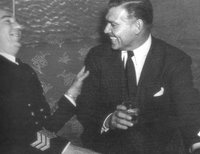 Clark Gable enjoys a laugh with a Cunard officer aboard the first Queen Mary.
Clark Gable enjoys a laugh with a Cunard officer aboard the first Queen Mary.
Photo Credit: Library of Congress Prints and Photographs Collection
Travel used to be something glamorous. Press photographers would board every great ocean liner after it entered New York harbor, eager to photograph the famous actors, former kings and statesmen aboard.
Ambitious mothers might scrimp to afford an ocean crossing in First Class, hopeful that their beautiful young daughter would catch the eye of an aristocrat or millionaire. Perhaps you have your own family story of how Aunt Edna was always in the lounge on the Queen Mary so she wouldn't miss rubbing elbows with Clark Gable on a voyage in '49.
It's a wonderful romantic memory that Cunard Line, who had so many of those great liners, has worked hard to recapture. Since the debut of Queen Mary 2 in 2004 it's become apparent to me that the most expensive and ambitious liner in history has successfully enticed the Jet Set to cross the Atlantic in a more civilized manner.
I'll confess, I'm a really big fan of Queen Mary 2 and the experiences of myself and my clients has only caused it to grow. Queen Mary 2 is an ocean liner, not a cruise ship. She's an ocean liner in every sense: engineering, itineraries and ambiance. I will omit the superlatives for today because I want to share some photos that I've gotten a kick out of lately. These pictures show today's glitterati aboard today's most glittering ship. (Click to enlarge photos) Actor Richard Dreyfuss (R) on the bridge with Commodore Warwick (L).
Actor Richard Dreyfuss (R) on the bridge with Commodore Warwick (L).
For this and following photos: Cunard Line (All Rights Reserved) Actress S. Epatha Merkerson from Law & Order enjoys Manhattan views before setting sail from Cunard's new terminal in Red Hook Brooklyn.
Actress S. Epatha Merkerson from Law & Order enjoys Manhattan views before setting sail from Cunard's new terminal in Red Hook Brooklyn. Author Sir Harold Evans and his wife Tina Brown (founding editor of Vanity Fair) enjoy some fresh air on Deck 12 of QM2.
Author Sir Harold Evans and his wife Tina Brown (founding editor of Vanity Fair) enjoy some fresh air on Deck 12 of QM2. George Lucas accepts an award aboard QM2 from Commodore Warwick during the Cannes Film Festival.
George Lucas accepts an award aboard QM2 from Commodore Warwick during the Cannes Film Festival.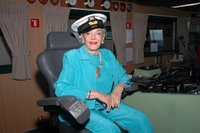 Legendary screen siren Jane Russell sits in the Captain's chair.
Legendary screen siren Jane Russell sits in the Captain's chair. Rocker Rod Stewart boards ship in Southampton.
Rocker Rod Stewart boards ship in Southampton. Another Englishman, John Cleese, poses on Queen Mary 2's bridge.
Another Englishman, John Cleese, poses on Queen Mary 2's bridge. Uma Thurman looks like she's already started to relax.
Uma Thurman looks like she's already started to relax.
Posted by
Christopher Gould
at
1:06 PM
1 comments
![]()
Labels: cruises DiggIt! add to Del.icio.us
Sunday, September 17, 2006
France, On the Canal du Nivernais
Photo Credit: Christopher Gould
Posted by
Christopher Gould
at
10:23 AM
0
comments
![]()
Labels: destinations DiggIt! add to Del.icio.us
Saturday, September 16, 2006
New Device to Make Flying Easier For Parents
If you’ve ever rushed to make a flight connection with bags, child seat, stroller and kid in tow you’d welcome some way to lighten your load, right? A new product called CARES (Child Aviation REStraint) may be just the thing. It’s a lightweight safety harness designed to replace rigid child safety seats on all aircraft types. The FAA approved the device, the first of its kind, last week.
CARES is designed to be used by children under 40 inches tall who weigh between 22 and 44 pounds. It weighs about one pound and can be packed into a six inch stuff sack. You can purchase CARES for $74.95 at the maker’s website.
Interestingly, kids aren’t required to use any safety devices. According to a recent FAA press release, “The agency encourages but does not mandate the use of child safety devices on airplanes because of the increased safety risk to families who, if forced to purchase an extra airline ticket, might choose to drive.”
Because my daughter weighs almost 44 pounds now, I won’t be able to benefit directly from CARES. I remember some trips where I would have paid a considerable amount of money to ensure my child’s safety if only I could have abandoned the car seat in an airport terminal somewhere. Parents with CARES will be able to check their car seats or arrange to reserve one with their rental car. I expect to see CARES in use onboard a flight very soon.
Posted by
Christopher Gould
at
9:19 AM
0
comments
![]()
Labels: air travel, kids DiggIt! add to Del.icio.us
Friday, September 15, 2006
Memorable Meals: New York City's Best Hot Dog
 Few food topics in New York generate as much furious debate as hot dogs. Pizza maybe, but that’s another post. On our most recent visit to the New York, my wife and I arrived with a comprehensive list of restaurants. We were still a little sketchy on the sightseeing, but every conceivable meal and snack was preplanned. Priorities, priorities.
Few food topics in New York generate as much furious debate as hot dogs. Pizza maybe, but that’s another post. On our most recent visit to the New York, my wife and I arrived with a comprehensive list of restaurants. We were still a little sketchy on the sightseeing, but every conceivable meal and snack was preplanned. Priorities, priorities.
As evening approached, we hopped the M1 bus uptown, I wanted to check out how the renovation of the Guggenheim was coming along. Instead we walked straight to the corner of 86th Street and Third Avenue for hot dogs from Papaya King. It’s a garishly-colored, neon-lit stand up joint famous for serving hot dogs and tropical juice drinks. There’s another one downtown and a few franchises too, but this one is the 74 year old original.
The dogs themselves, made to Papaya King specs by Sabrett, are cooked on a griddle and served in toasted buns. We both ordered the two dog special with Papaya Drink.
The tiny restaurant itself is not a great place to eat your meal, so we walked the two blocks over to Fifth Avenue and settled on a bench on the Central Park side. The weather was balmy and we enjoyed watching the city go by. It’s a pretty classy neighborhood with some of the most expensive real estate in America.
Right across the avenue at 86th is the Neue Galerie, the museum of Austrian and German Art that’s housed in a Gilded Age mansion. We didn’t go inside to check out Gustav Klimt’s Adele Bloch-Bauer I, which captured the auction sales record in June when it was purchased for $135 million.
Frothy papaya drinks are an excellent accompaniment to the savory meaty dogs, just the right mellow counterpoint. I can’t quite place the special spices in the franks themselves, but garlic is pretty apparent. The perfect, not overdone griddle-top cooking enhances the snap of the natural casing. Topped with a little brown mustard, kraut, onions or Papaya King’s own tropical relish they are, like the slogan says, “tastier than filet mignon.”
I think that they’re the best hot dogs in New York. I can’t wait to hear from those of you who disagree. Remember that disparate foodies like Julia Child and Anthony Bourdain agree with me. Bourdain wrote about perfect meals in the closing chapter of A Cook’s Tour: “Your last Papaya King hot dog takes on golden, even mythic, proportions when remembered from a distance.” How right he is.
Photo Credit: Christopher Gould (click the picture for near life size)
Posted by
Christopher Gould
at
8:58 AM
0
comments
![]()
Labels: destinations, food DiggIt! add to Del.icio.us
Wednesday, September 13, 2006
Luxe Limousines of Asian Hotels
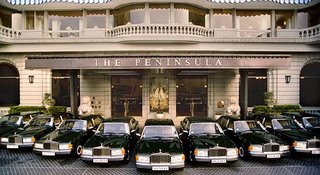
The prestige of staying at one of the world’s best hotels is measured in the details of the experience. Exotic linens, exclusive toiletries, private butlers and five-star dining are de rigueur; many guests also require a car and driver. In Asia, where face is everything, landmark hotels have a long tradition of private limousine service. Tycoons and Tai-Pans have long recognized the value of arriving for a negotiation in the liveried limousine of the best place in town.
The Peninsula Hotel casts a long shadow over its competitors in Hong Kong, not the least because of their legendary fleet of green Rolls-Royce automobiles. The Peninsula’s Rolls fleet, reputedly the largest in the world, recollects the British heritage of the oldest hotel in the former Crown Colony.
I’m amazed by how many times the Peninsula’s limousines find their way into films and novels. James Bond (Roger Moore) shows that he knows the best way to get around Kowloon in the 1974 film The Man With the Golden Gun. James Clavell’s best-selling novel, Noble House, fictionalized Hong Kong’s most famous traders and its most famous hotel with, of course, green Rolls-Royces. One of his characters even muses, “Soon I'm going to have one of these, he thought. A Rolls of my own.”
Anyone who’s visited Tokyo knows that the streets are jammed with little Toyotas and Nissans from Shibuya to Harajuku. Imagine cruising those same streets in a mirror-black Cadillac Stretch Limousine bearing the discreet badge of the Imperial Hotel.
The Imperial is the address for captains of industry. With a dramatic history stretching back 125 years, the Imperial is an institution that has been central to the rise of modern Tokyo. So, wave to the Emperor (across the street) as you pull out of the driveway seated behind your white-gloved driver, confident that you’ve already arrived.
Finally, the ne plus ultra of colonial era hotels in Asia is Singapore’s Raffles Hotel. This bastion of tradition, host to the likes of Kipling, Somerset Maugham and the Queen herself, has just updated their limousine offering. Robert Logan, Raffles Hotel General Manager, announced that they have commissioned a Bentley Continental Flying Spur to act as their limousine and “to create memorable experiences for all our guests.” The vehicle’s body is laser welded in Germany and then hand assembled over three months in Crewe, England.
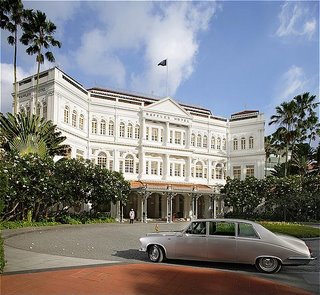
I think that this particular car is an inspired choice, a 21st Century motorcar from a most traditional marque. Excited by the photos, I phoned Mike McElroy of Bentley Atlanta to find out what it takes to own your own Flying Spur. It’s the fastest sedan in the world, with a 552HP engine that starts at $169,990 base price with plenty of room to go higher for extras, he informed me. Extras like the hotel’s monogram on the interior leather. Nice.
If you’re inspired to try a ride in any of these rides, give me a call. If you want one for yourself later, call Mike.
Photo Credit (Top): The Peninsula Hong Kong
Photo Credit (Bottom): Raffles Hotel, Singapore
Posted by
Christopher Gould
at
8:14 PM
0
comments
![]()
Labels: destinations, hotels DiggIt! add to Del.icio.us
Monday, September 11, 2006
Five years on
so just remember.
Never forget,
and resolve
that fear will not change
how you live.
Photo Credit: Library of Congress, Prints and Photographs Collection
Posted by
Christopher Gould
at
1:09 PM
0
comments
![]()
Sunday, September 10, 2006
United Airlines Introduces New Fast Boarding Technology
Presumably passengers already aboard the aircraft are instructed to exit through the forward door while new passengers board through the rear (or vice versa). United hasn’t said who uses which door. I don’t think that they’d alter the existing paradigm that places their high revenue passengers and those that need assistance up front. I hope that I won’t be telling some of my clients, “you really want to be in the last row next to the bathroom so you’ll be first off the plane.”
United started using the DoubleDocker™ this week at gate B15 at Denver International Airport. If it meets their expectations, they’ll probably buy more, but only if it makes financial sense. According to Alex Marren, Vice President of Operational Services for United Express and Ted, “…because we can board customers faster, we are able to eventually add more flights without adding new aircraft.”
The DoubleDocker™ is designed to be used with narrow body aircraft, like the Airbus A320 and Boeing 737 currently used by United. I wonder how many DoubleDockers™ you could buy for the price of one A320?
I think that this is an exciting development. I can’t wait to hear what passengers think and to try it for myself.
Last week there was other aviation news with the first passenger flight of the double deck Airbus A380. I know that new design double deck jet bridges that allow boarding the upper and lower decks simultaneously have been developed specifically for that aircraft.
I wonder if Dewbridge is looking at combining the DoubleDocker™ with the double decker? What would they call it? Double-double? The Quad? Whatever they design, I’m sure that air passengers will be coming and going at the same time.
Photo Credit: Dew Engineering and Development Limited
Posted by
Christopher Gould
at
10:08 AM
2
comments
![]()
Labels: air travel DiggIt! add to Del.icio.us
Friday, September 08, 2006
Tables with a view: Chicago
Chicago, one of my favorite cities, offers a glittering cityscape at night and architectural splendors by day. Here’s my pick for how to spend one day eating and taking in the view.
Breakfast: McDonald’s at Chicago Place
This pick may come as a surprise, but it is undoubtedly the best view per dollar spent in Chicago. Chicago Place is a vertical shopping mall located at 700 N. Michigan Avenue. Head to the tenth floor and find the food court. It doesn’t look like much – look for the large dining room hidden past the counter. Floor to ceiling windows offer sweeping views down Michigan Avenue towards Tribune Tower and the bridge – the people eating in the food court don’t even know this view exists. McMuffin eating at its best.
Lunch: The Signature Room at the 95th
The highest restaurant in the country, on the 95th and 96th floors of the John Hancock Center. The food is quite good, although some critics grouse that it doesn’t live up to the prices. While that may be true at dinner time, lunch is a bargain, with most entrees priced $15 or less. The service is polished and the views are jaw-dropping. If you want to see the view by night, try their bar on the 96th floor. It’s a much more civilized way to take in the view than the public observation deck two floors below. For about the same price Joe Tourist pays for the observation deck, you can enjoy a signature martini in the swank surroundings.
Dinner: Everest
Chef Jean Joho has created one of the world’s best restaurants in a setting with incredible views. Located on the 40th floor of the Chicago Stock Exchange Building you can enjoy a seasonal menu of local ingredients filtered through the sensibility of the chef’s Alsatian roots. It isn’t cheap, but you get what you pay for – it’s worth every penny. Savor the Roasted Maine Lobster in Alsace Gewurztraminer Butter and Ginger as you end the day here, high above the sparkling lights and remember perhaps, your breakfast McMuffin.
Photo Credit: Kevin P. Martin
Posted by
Christopher Gould
at
3:58 PM
3
comments
![]()
Labels: destinations, food DiggIt! add to Del.icio.us
Thursday, September 07, 2006
World Food in Your Mailbox: Austria
While looking at some menus, I was pleased to discover that the most famous maker of Linzertorte now delivers their famous cakes all over the world from their bakery in Linz. Konditorei Jindrak is the most famous maker of the centuries-old recipe of almonds and raspberry jam. I might order one for Thanksgiving.
Photo Credit: Austrian Tourist Office
Posted by
Christopher Gould
at
2:55 PM
0
comments
![]()
Labels: food DiggIt! add to Del.icio.us
Monday, September 04, 2006
Steve Irwin 1962 - 2006
I was saddened to hear of the death of Steve “The Crocodile Hunter” Irwin earlier today. He died doing something he loves and I’ll bet he wouldn’t have changed how he lived his life, even if he knew how it would end up.
Press reports are focusing on his contributions as an environmentalist; I want to point out that his contributions to Australia’s tourism are incalculable. Although I never visited his Australia Zoo near Brisbane, I always recommended it to my clients who traveled to the area. They always had a wonderful time and brought back great pictures and video that they shared with me. Those that actually got to meet Steve usually called it the highlight of their trip.
Although he won’t be there in the future, I’m sure his legend will grow and continue to inspire people to come to Australia and learn about its wildlife that he loved so much.
Posted by
Christopher Gould
at
9:52 AM
0
comments
![]()
Saturday, September 02, 2006
Once Upon a Time at the Gas Pump
An article about King’s Canyon National Park in yesterday’s New York Times got me thinking about my trip there in 2003. I took my family on a great road trip – we flew to Las Vegas, rented a car and camped while visiting four National Parks: Death Valley, Sequoia, King’s Canyon and Yosemite.
I used to have an interesting little story from King’s Canyon. Less than three years later, it’s not so interesting anymore. It was the story I called “The highest price I ever paid for gas in the United States” (once upon a time).
On September 6, 2003 I paid $2.79 per gallon at the only gas pump in King’s Canyon National Park. It was shocking at the time. Sure, I’d paid more in Europe – probably that much per liter – but this was America! Still, we didn’t mind spending the money, the scenery was beautiful and it was very remote from any other competition. We paid our money, smiled inwardly, and went on our way. Today I looked up prices from that week on the Department of Energy website. The national average was $1.61.
After we returned home, I enjoyed telling people about that experience for a while and it never failed to impress. I forgot about it until yesterday when I read that article and it made me nostalgic for the good old days: three years ago.
Posted by
Christopher Gould
at
3:47 PM
0
comments
![]()
Labels: destinations DiggIt! add to Del.icio.us
Friday, September 01, 2006
Memorable Meals: Munich
I’ve gotten some feedback that some of you would like to hear about my favorite places to eat in the world. Today I’m beginning a series called “Memorable Meals” where I will write about those places that loom large in my memory, rather than my latest restaurant experience. I will, of course, include the latest information about the establishment in case you’re inspired to seek it out on your own.
There’s a German word, gemütlich, which means pleasant and congenial and has connotations of coziness. I found the embodiment of that word as I stepped through the doorway of a small 400 year old stone building in Munich’s Viktualienmarkt on a gray rainy evening. The Bratwurstherzl
restaurant is at least as old as the Viktualienmarkt, where meats and produce have been offered in the open air daily for nearly 200 years. I imagine that their earliest customers would feel right at home there today. Though it’s close to the heart of the tourist Munich, the majority of patrons always seem to be speaking German.
Here homemade bratwurst is grilled over beechwood coals and the local Hacker-Pschorr beer is tapped from a wooden barrel. Although there’s an extensive menu of Bavarian specialties, I wasn’t going to visit the Bratwurstherzl and skip the bratwurst. I ordered a plate of twelve sausages with Weinsauerkraut and a beer. Now before you get too excited about the twelve sausages, let me explain that traditional Bavarian bratwurst is made into small links about the size of American breakfast links.
The bratwurst was served on a heart-shaped tin plate with the Weinsauerkraut in a separate dish. It was quite simply the best sausage, the best beer and the best kraut I’ve ever had. Ever. The bratwurst was juicy without being greasy and was delicately perfumed by the beechwood smoke. The kraut was not too sour, filled with complex flavors, nothing like the hot dog topping we know in the States. The beer was sublime, with a wonderful yeasty, slightly floral taste and a long-lasting foamy head.
I think that this place is so special, that it’s worth visiting every time you’re in Munich to sample the old favorites and try new ones like traditional pretzels and schnitzels. My clients have come back with glowing reports after I recommended it to them. Why don’t you try it too?
Bratwurstherzl is located at number 1 Dreifaltigkeitsplatz not far from the Marienplatz subway station. They’re open seven days a week for lunch and dinner.
Photo Credit: Becky Gould
Posted by
Christopher Gould
at
12:57 PM
0
comments
![]()
Labels: destinations, food DiggIt! add to Del.icio.us
Thursday, August 31, 2006
My Secret Cruise Ship Sport

It’s time to sail. All passengers were warned to be aboard 29 minutes ago. The gangplank has been run in and mooring lines are let go. The Captain and another white-shirted officer watch from the pier side bridge wing. He turns towards the helm position and gives an order to an unseen person. A long, earsplitting blast sounds from the ship’s whistle while the thrusters whirl to life and push the ship away from the pier.
Passengers are watching from the rail on the top deck, savoring the end of a day in port before heading to their cabin for a shower before dinner. A few, including myself, are focused intently on the street at the end of the pier; waiting for the inevitable drama. I raise my binoculars in time to see a taxi screech to a halt by the security gate. Three young women emerge waving their arms at the ship. They run, camera bags and backpacks flopping in every direction, down the thousand foot long pier. I can see by their expressions that they realize that a 962 foot long ship doesn’t stop for late passengers once it’s underway.
I’ve seen this happen on every Caribbean cruise I’ve been on – especially in ports with lots of bars. It never seems to happen in Oslo or Ketchikan, I guess because those ports don’t have a Señor Frog’s. If you miss the boat, you can rejoin at the next port – at your own expense.
This particular story has a happy ending, though. The girls are pretty and the gallant men of the Cozumel harbor patrol agree to ferry them out on the Pilot boat. So let this be a lesson for you: don’t miss the boat -- or, the next time you’re on a cruise, bring your binoculars out on deck when you sail away – that’s where I’ll be.
Photo Credit: Christopher Gould
Posted by
Christopher Gould
at
5:17 PM
1 comments
![]()
Labels: cruises DiggIt! add to Del.icio.us
Wednesday, August 30, 2006
Watch Your A** On This Plane

You can file this under oversensitive airline nit-picking if you want, but oh my aching tuckus.
I’m sitting on a flight ready to roll back from the gate, privately congratulating myself for scoring an exit row seat. Ninety-four minutes later, I didn’t feel so great, my backside was aching and I was happy to be at my destination.
A few weeks later, same thing: my smugness fades early and the extra legroom in the exit row isn’t a consolation. I realize that this is the same type of aircraft as before, a Canadair CRJ700, made by Bombardier Aerospace. I experiment with other seats on the plane and quickly determine that there’s far less padding on the seats in the exit row. This must be motivated by some safety concern on the part of the designers. Are they kidding? Do people really get bogged down in the cushy soft pads of other aircraft seats? In coach? Give me a break.
The CRJ700 is a very popular plane and is operated by lots of carriers including American, US Airways, Delta, Lufthansa, British Airways, and Air France among others. I like it for lots of other reasons, but it’s more fun to complain. For now, my clients and I will make do with less legroom.
Photo Credit: Bombardier Inc.
Posted by
Christopher Gould
at
10:35 AM
0
comments
![]()
Labels: air travel DiggIt! add to Del.icio.us

